Financial Decision Making Report: BM414, SKANSKA PLC Analysis
VerifiedAdded on 2023/01/05
|12
|3394
|93
Report
AI Summary
This report delves into the critical aspects of financial decision-making within the context of SKANSKA PLC, a UK-based construction company. It begins by evaluating the significance of accounting and finance functions, encompassing financial accounting, management accounting, tax, and auditing within the accounting department, and investment, financing, dividend, and working capital functions within the finance department. The report then proceeds to a detailed financial analysis of SKANSKA PLC, calculating and interpreting key financial ratios such as Return on Capital Employed (ROCE), Net Profit Margin, Current Ratio, Debtor's Collection Period, and Creditor's Collection Period for the years 2018 and 2019. The analysis reveals the company's financial performance and position, providing insights for investors and stakeholders. Based on the findings, the report concludes with an investment recommendation for SKANSKA PLC.
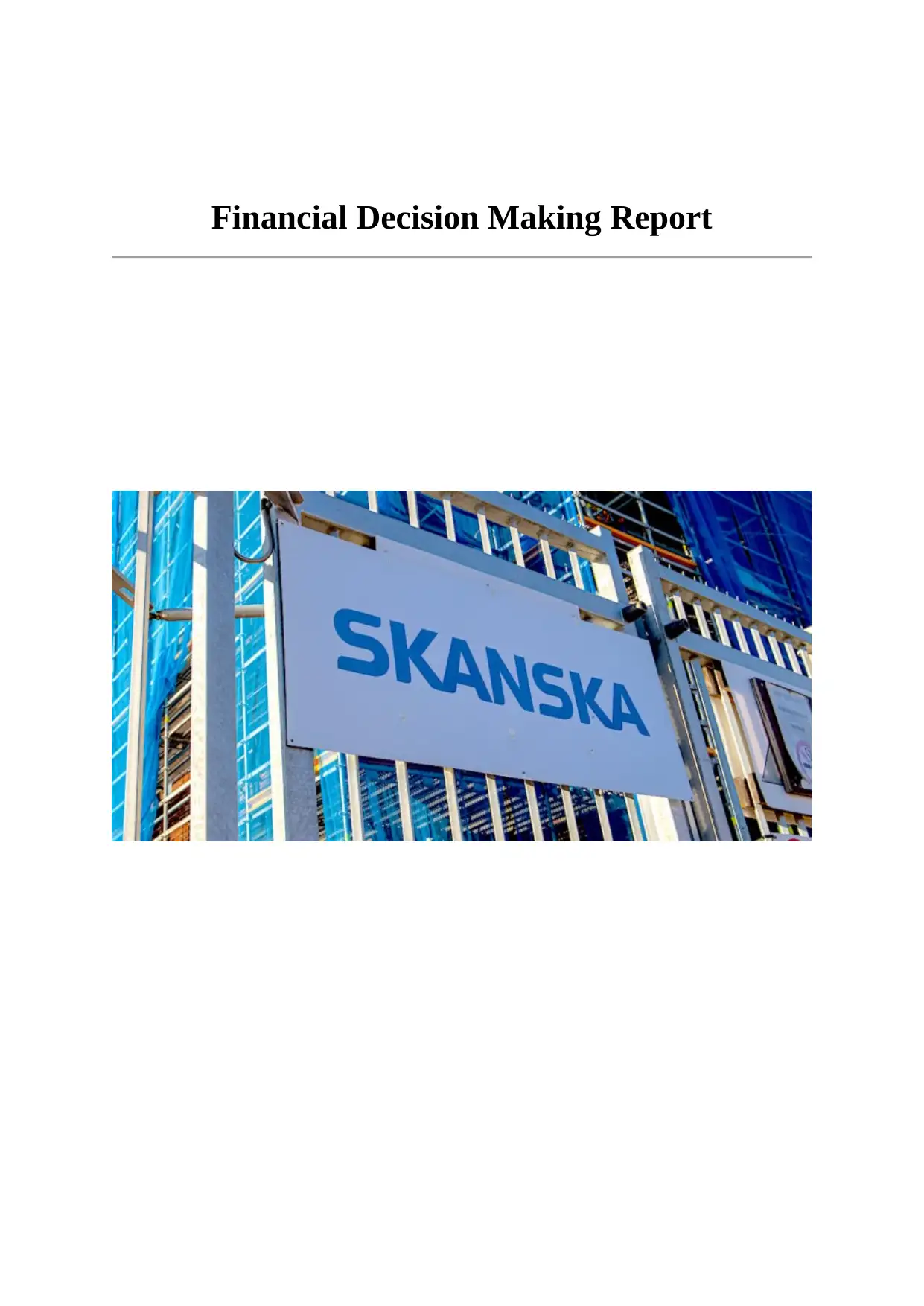
Financial Decision Making Report
Paraphrase This Document
Need a fresh take? Get an instant paraphrase of this document with our AI Paraphraser
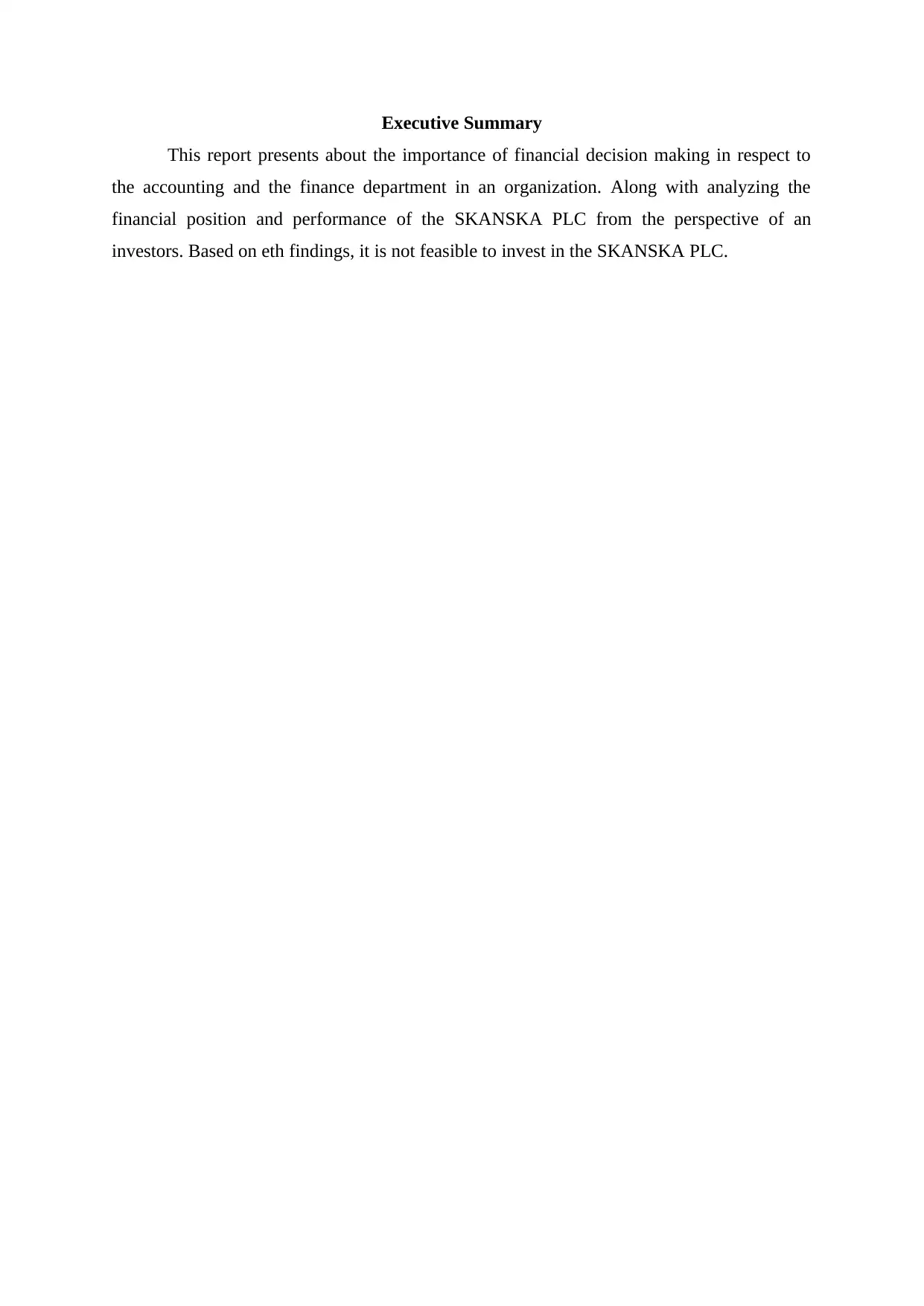
Executive Summary
This report presents about the importance of financial decision making in respect to
the accounting and the finance department in an organization. Along with analyzing the
financial position and performance of the SKANSKA PLC from the perspective of an
investors. Based on eth findings, it is not feasible to invest in the SKANSKA PLC.
This report presents about the importance of financial decision making in respect to
the accounting and the finance department in an organization. Along with analyzing the
financial position and performance of the SKANSKA PLC from the perspective of an
investors. Based on eth findings, it is not feasible to invest in the SKANSKA PLC.
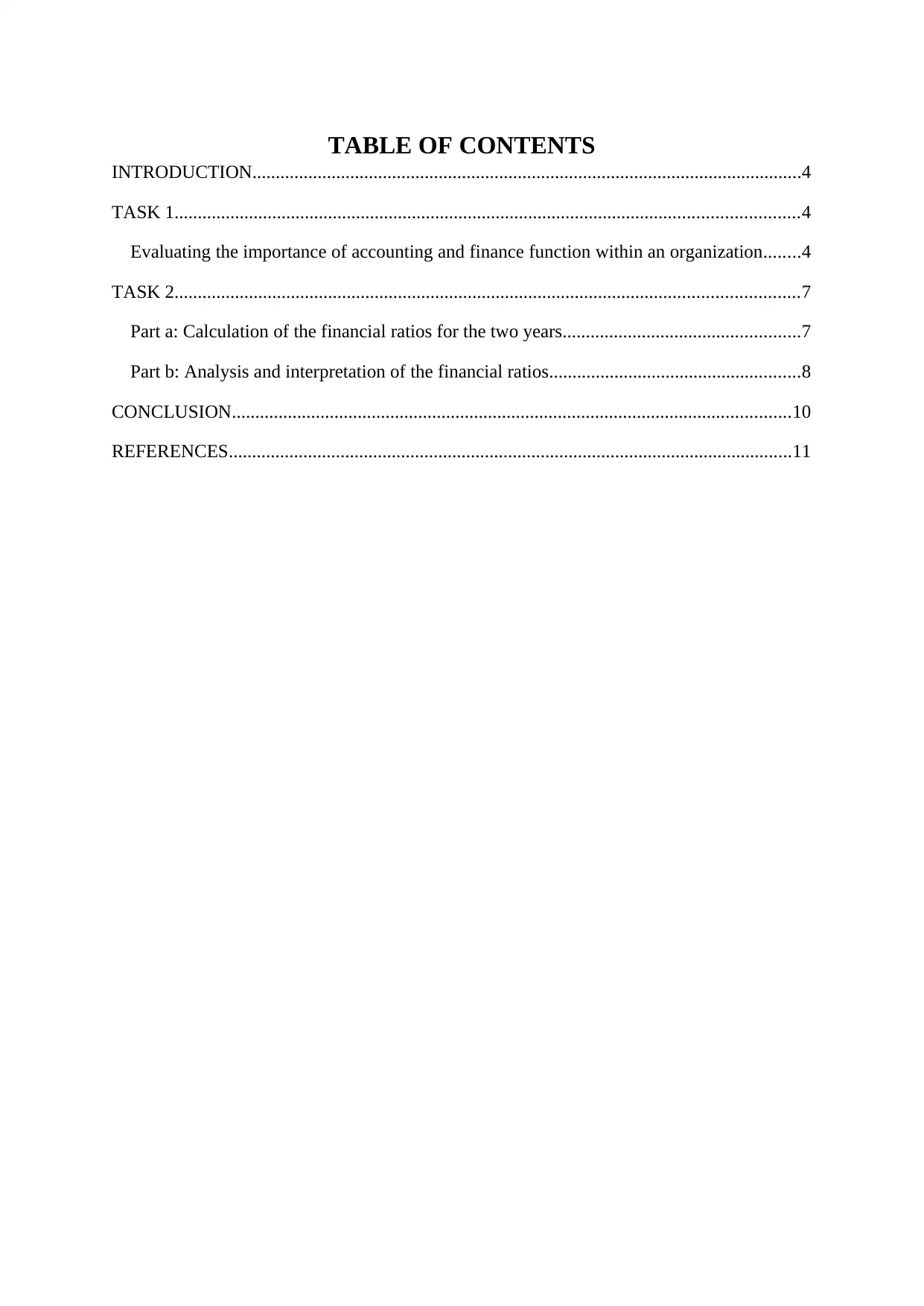
TABLE OF CONTENTS
INTRODUCTION......................................................................................................................4
TASK 1......................................................................................................................................4
Evaluating the importance of accounting and finance function within an organization........4
TASK 2......................................................................................................................................7
Part a: Calculation of the financial ratios for the two years...................................................7
Part b: Analysis and interpretation of the financial ratios......................................................8
CONCLUSION........................................................................................................................10
REFERENCES.........................................................................................................................11
INTRODUCTION......................................................................................................................4
TASK 1......................................................................................................................................4
Evaluating the importance of accounting and finance function within an organization........4
TASK 2......................................................................................................................................7
Part a: Calculation of the financial ratios for the two years...................................................7
Part b: Analysis and interpretation of the financial ratios......................................................8
CONCLUSION........................................................................................................................10
REFERENCES.........................................................................................................................11
⊘ This is a preview!⊘
Do you want full access?
Subscribe today to unlock all pages.

Trusted by 1+ million students worldwide
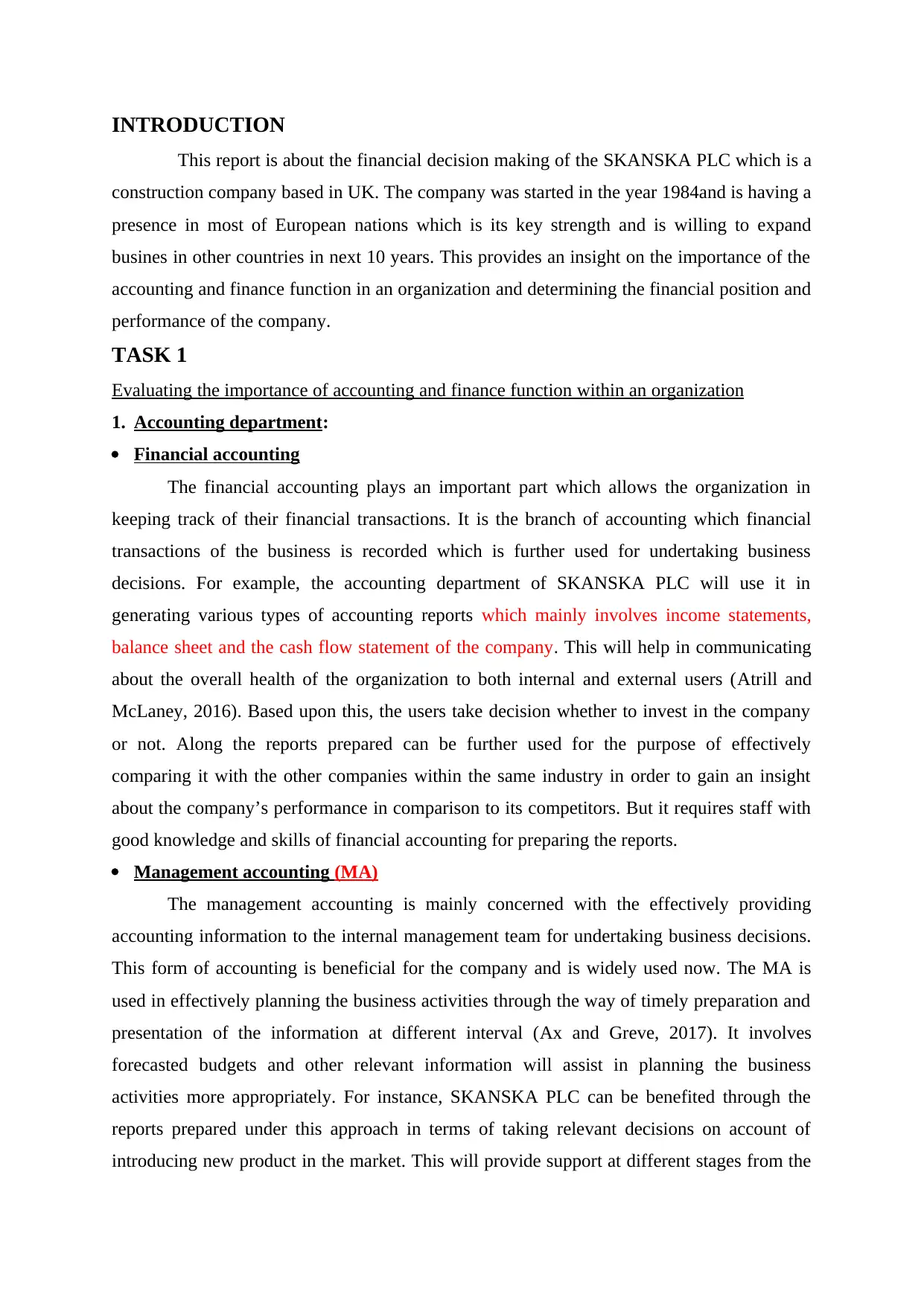
INTRODUCTION
This report is about the financial decision making of the SKANSKA PLC which is a
construction company based in UK. The company was started in the year 1984and is having a
presence in most of European nations which is its key strength and is willing to expand
busines in other countries in next 10 years. This provides an insight on the importance of the
accounting and finance function in an organization and determining the financial position and
performance of the company.
TASK 1
Evaluating the importance of accounting and finance function within an organization
1. Accounting department:
Financial accounting
The financial accounting plays an important part which allows the organization in
keeping track of their financial transactions. It is the branch of accounting which financial
transactions of the business is recorded which is further used for undertaking business
decisions. For example, the accounting department of SKANSKA PLC will use it in
generating various types of accounting reports which mainly involves income statements,
balance sheet and the cash flow statement of the company. This will help in communicating
about the overall health of the organization to both internal and external users (Atrill and
McLaney, 2016). Based upon this, the users take decision whether to invest in the company
or not. Along the reports prepared can be further used for the purpose of effectively
comparing it with the other companies within the same industry in order to gain an insight
about the company’s performance in comparison to its competitors. But it requires staff with
good knowledge and skills of financial accounting for preparing the reports.
Management accounting (MA)
The management accounting is mainly concerned with the effectively providing
accounting information to the internal management team for undertaking business decisions.
This form of accounting is beneficial for the company and is widely used now. The MA is
used in effectively planning the business activities through the way of timely preparation and
presentation of the information at different interval (Ax and Greve, 2017). It involves
forecasted budgets and other relevant information will assist in planning the business
activities more appropriately. For instance, SKANSKA PLC can be benefited through the
reports prepared under this approach in terms of taking relevant decisions on account of
introducing new product in the market. This will provide support at different stages from the
This report is about the financial decision making of the SKANSKA PLC which is a
construction company based in UK. The company was started in the year 1984and is having a
presence in most of European nations which is its key strength and is willing to expand
busines in other countries in next 10 years. This provides an insight on the importance of the
accounting and finance function in an organization and determining the financial position and
performance of the company.
TASK 1
Evaluating the importance of accounting and finance function within an organization
1. Accounting department:
Financial accounting
The financial accounting plays an important part which allows the organization in
keeping track of their financial transactions. It is the branch of accounting which financial
transactions of the business is recorded which is further used for undertaking business
decisions. For example, the accounting department of SKANSKA PLC will use it in
generating various types of accounting reports which mainly involves income statements,
balance sheet and the cash flow statement of the company. This will help in communicating
about the overall health of the organization to both internal and external users (Atrill and
McLaney, 2016). Based upon this, the users take decision whether to invest in the company
or not. Along the reports prepared can be further used for the purpose of effectively
comparing it with the other companies within the same industry in order to gain an insight
about the company’s performance in comparison to its competitors. But it requires staff with
good knowledge and skills of financial accounting for preparing the reports.
Management accounting (MA)
The management accounting is mainly concerned with the effectively providing
accounting information to the internal management team for undertaking business decisions.
This form of accounting is beneficial for the company and is widely used now. The MA is
used in effectively planning the business activities through the way of timely preparation and
presentation of the information at different interval (Ax and Greve, 2017). It involves
forecasted budgets and other relevant information will assist in planning the business
activities more appropriately. For instance, SKANSKA PLC can be benefited through the
reports prepared under this approach in terms of taking relevant decisions on account of
introducing new product in the market. This will provide support at different stages from the
Paraphrase This Document
Need a fresh take? Get an instant paraphrase of this document with our AI Paraphraser
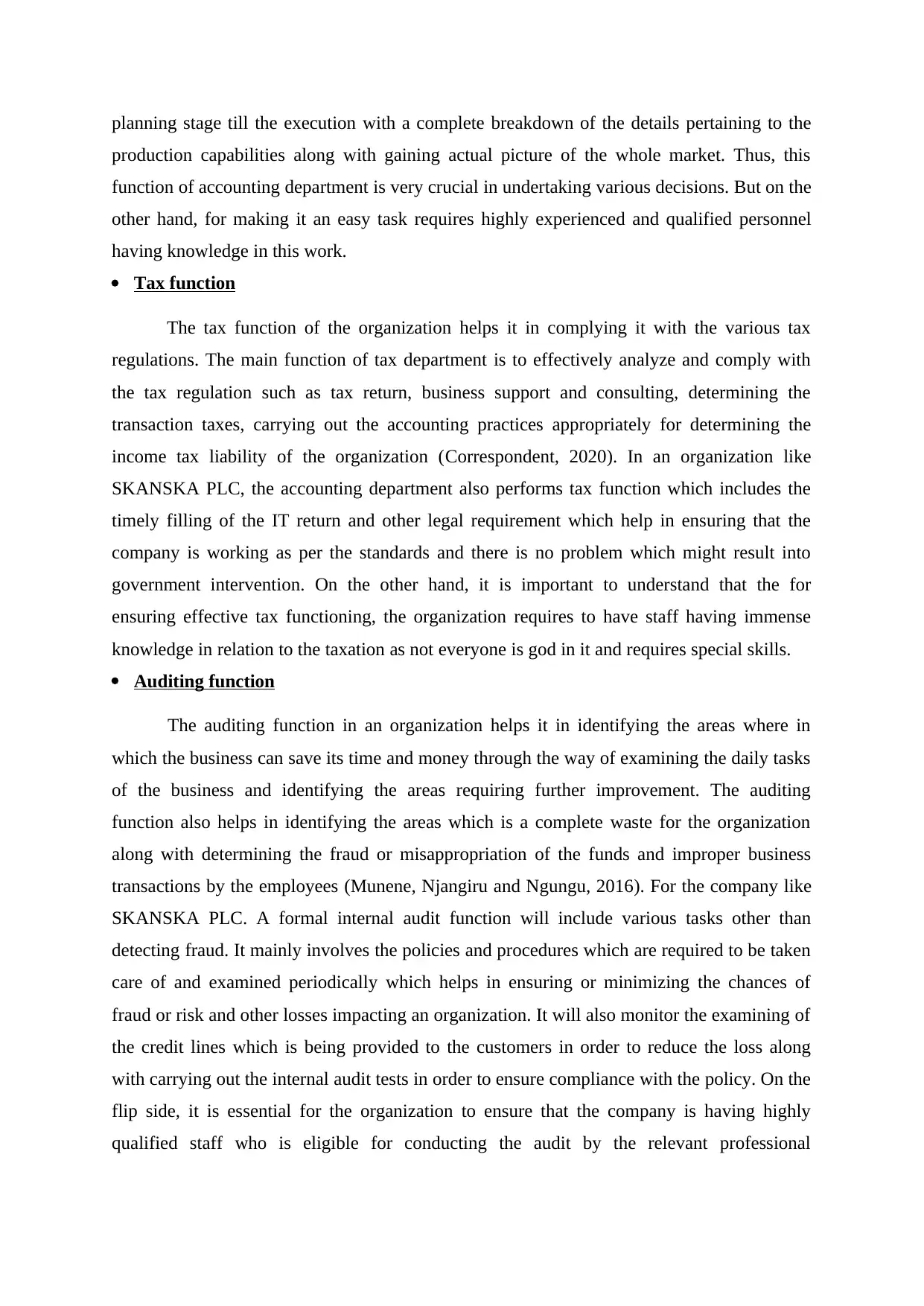
planning stage till the execution with a complete breakdown of the details pertaining to the
production capabilities along with gaining actual picture of the whole market. Thus, this
function of accounting department is very crucial in undertaking various decisions. But on the
other hand, for making it an easy task requires highly experienced and qualified personnel
having knowledge in this work.
Tax function
The tax function of the organization helps it in complying it with the various tax
regulations. The main function of tax department is to effectively analyze and comply with
the tax regulation such as tax return, business support and consulting, determining the
transaction taxes, carrying out the accounting practices appropriately for determining the
income tax liability of the organization (Correspondent, 2020). In an organization like
SKANSKA PLC, the accounting department also performs tax function which includes the
timely filling of the IT return and other legal requirement which help in ensuring that the
company is working as per the standards and there is no problem which might result into
government intervention. On the other hand, it is important to understand that the for
ensuring effective tax functioning, the organization requires to have staff having immense
knowledge in relation to the taxation as not everyone is god in it and requires special skills.
Auditing function
The auditing function in an organization helps it in identifying the areas where in
which the business can save its time and money through the way of examining the daily tasks
of the business and identifying the areas requiring further improvement. The auditing
function also helps in identifying the areas which is a complete waste for the organization
along with determining the fraud or misappropriation of the funds and improper business
transactions by the employees (Munene, Njangiru and Ngungu, 2016). For the company like
SKANSKA PLC. A formal internal audit function will include various tasks other than
detecting fraud. It mainly involves the policies and procedures which are required to be taken
care of and examined periodically which helps in ensuring or minimizing the chances of
fraud or risk and other losses impacting an organization. It will also monitor the examining of
the credit lines which is being provided to the customers in order to reduce the loss along
with carrying out the internal audit tests in order to ensure compliance with the policy. On the
flip side, it is essential for the organization to ensure that the company is having highly
qualified staff who is eligible for conducting the audit by the relevant professional
production capabilities along with gaining actual picture of the whole market. Thus, this
function of accounting department is very crucial in undertaking various decisions. But on the
other hand, for making it an easy task requires highly experienced and qualified personnel
having knowledge in this work.
Tax function
The tax function of the organization helps it in complying it with the various tax
regulations. The main function of tax department is to effectively analyze and comply with
the tax regulation such as tax return, business support and consulting, determining the
transaction taxes, carrying out the accounting practices appropriately for determining the
income tax liability of the organization (Correspondent, 2020). In an organization like
SKANSKA PLC, the accounting department also performs tax function which includes the
timely filling of the IT return and other legal requirement which help in ensuring that the
company is working as per the standards and there is no problem which might result into
government intervention. On the other hand, it is important to understand that the for
ensuring effective tax functioning, the organization requires to have staff having immense
knowledge in relation to the taxation as not everyone is god in it and requires special skills.
Auditing function
The auditing function in an organization helps it in identifying the areas where in
which the business can save its time and money through the way of examining the daily tasks
of the business and identifying the areas requiring further improvement. The auditing
function also helps in identifying the areas which is a complete waste for the organization
along with determining the fraud or misappropriation of the funds and improper business
transactions by the employees (Munene, Njangiru and Ngungu, 2016). For the company like
SKANSKA PLC. A formal internal audit function will include various tasks other than
detecting fraud. It mainly involves the policies and procedures which are required to be taken
care of and examined periodically which helps in ensuring or minimizing the chances of
fraud or risk and other losses impacting an organization. It will also monitor the examining of
the credit lines which is being provided to the customers in order to reduce the loss along
with carrying out the internal audit tests in order to ensure compliance with the policy. On the
flip side, it is essential for the organization to ensure that the company is having highly
qualified staff who is eligible for conducting the audit by the relevant professional
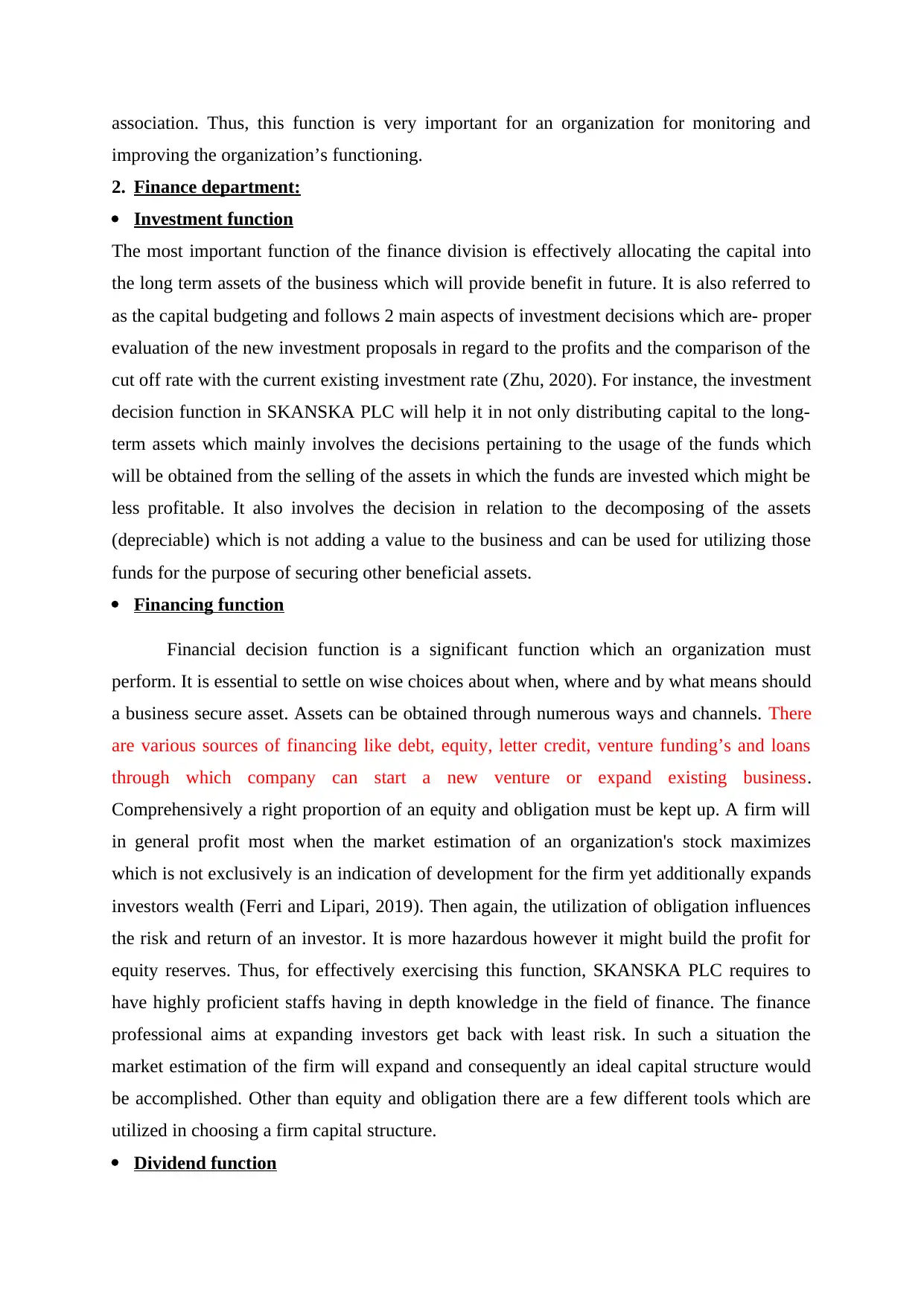
association. Thus, this function is very important for an organization for monitoring and
improving the organization’s functioning.
2. Finance department:
Investment function
The most important function of the finance division is effectively allocating the capital into
the long term assets of the business which will provide benefit in future. It is also referred to
as the capital budgeting and follows 2 main aspects of investment decisions which are- proper
evaluation of the new investment proposals in regard to the profits and the comparison of the
cut off rate with the current existing investment rate (Zhu, 2020). For instance, the investment
decision function in SKANSKA PLC will help it in not only distributing capital to the long-
term assets which mainly involves the decisions pertaining to the usage of the funds which
will be obtained from the selling of the assets in which the funds are invested which might be
less profitable. It also involves the decision in relation to the decomposing of the assets
(depreciable) which is not adding a value to the business and can be used for utilizing those
funds for the purpose of securing other beneficial assets.
Financing function
Financial decision function is a significant function which an organization must
perform. It is essential to settle on wise choices about when, where and by what means should
a business secure asset. Assets can be obtained through numerous ways and channels. There
are various sources of financing like debt, equity, letter credit, venture funding’s and loans
through which company can start a new venture or expand existing business.
Comprehensively a right proportion of an equity and obligation must be kept up. A firm will
in general profit most when the market estimation of an organization's stock maximizes
which is not exclusively is an indication of development for the firm yet additionally expands
investors wealth (Ferri and Lipari, 2019). Then again, the utilization of obligation influences
the risk and return of an investor. It is more hazardous however it might build the profit for
equity reserves. Thus, for effectively exercising this function, SKANSKA PLC requires to
have highly proficient staffs having in depth knowledge in the field of finance. The finance
professional aims at expanding investors get back with least risk. In such a situation the
market estimation of the firm will expand and consequently an ideal capital structure would
be accomplished. Other than equity and obligation there are a few different tools which are
utilized in choosing a firm capital structure.
Dividend function
improving the organization’s functioning.
2. Finance department:
Investment function
The most important function of the finance division is effectively allocating the capital into
the long term assets of the business which will provide benefit in future. It is also referred to
as the capital budgeting and follows 2 main aspects of investment decisions which are- proper
evaluation of the new investment proposals in regard to the profits and the comparison of the
cut off rate with the current existing investment rate (Zhu, 2020). For instance, the investment
decision function in SKANSKA PLC will help it in not only distributing capital to the long-
term assets which mainly involves the decisions pertaining to the usage of the funds which
will be obtained from the selling of the assets in which the funds are invested which might be
less profitable. It also involves the decision in relation to the decomposing of the assets
(depreciable) which is not adding a value to the business and can be used for utilizing those
funds for the purpose of securing other beneficial assets.
Financing function
Financial decision function is a significant function which an organization must
perform. It is essential to settle on wise choices about when, where and by what means should
a business secure asset. Assets can be obtained through numerous ways and channels. There
are various sources of financing like debt, equity, letter credit, venture funding’s and loans
through which company can start a new venture or expand existing business.
Comprehensively a right proportion of an equity and obligation must be kept up. A firm will
in general profit most when the market estimation of an organization's stock maximizes
which is not exclusively is an indication of development for the firm yet additionally expands
investors wealth (Ferri and Lipari, 2019). Then again, the utilization of obligation influences
the risk and return of an investor. It is more hazardous however it might build the profit for
equity reserves. Thus, for effectively exercising this function, SKANSKA PLC requires to
have highly proficient staffs having in depth knowledge in the field of finance. The finance
professional aims at expanding investors get back with least risk. In such a situation the
market estimation of the firm will expand and consequently an ideal capital structure would
be accomplished. Other than equity and obligation there are a few different tools which are
utilized in choosing a firm capital structure.
Dividend function
⊘ This is a preview!⊘
Do you want full access?
Subscribe today to unlock all pages.

Trusted by 1+ million students worldwide
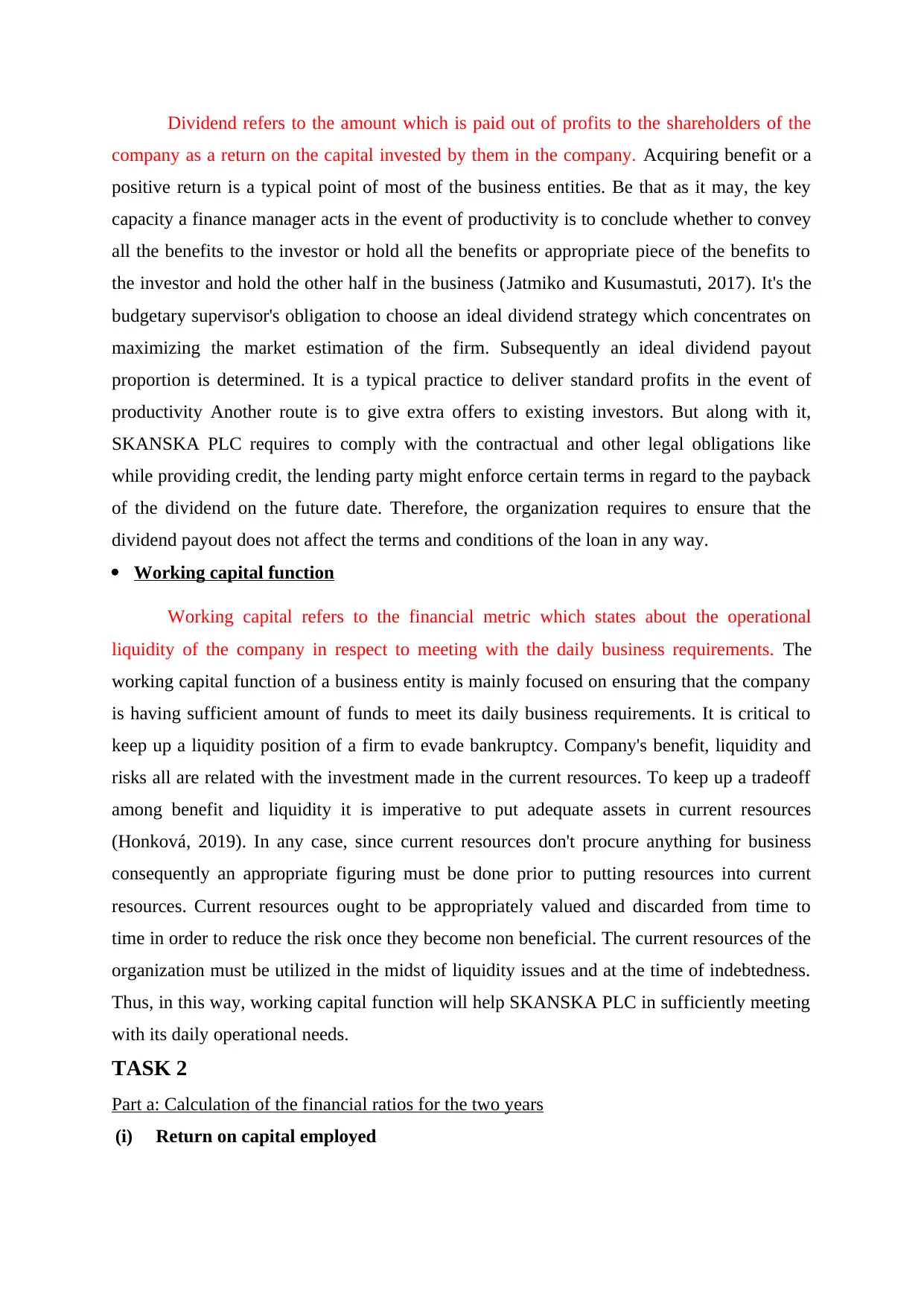
Dividend refers to the amount which is paid out of profits to the shareholders of the
company as a return on the capital invested by them in the company. Acquiring benefit or a
positive return is a typical point of most of the business entities. Be that as it may, the key
capacity a finance manager acts in the event of productivity is to conclude whether to convey
all the benefits to the investor or hold all the benefits or appropriate piece of the benefits to
the investor and hold the other half in the business (Jatmiko and Kusumastuti, 2017). It's the
budgetary supervisor's obligation to choose an ideal dividend strategy which concentrates on
maximizing the market estimation of the firm. Subsequently an ideal dividend payout
proportion is determined. It is a typical practice to deliver standard profits in the event of
productivity Another route is to give extra offers to existing investors. But along with it,
SKANSKA PLC requires to comply with the contractual and other legal obligations like
while providing credit, the lending party might enforce certain terms in regard to the payback
of the dividend on the future date. Therefore, the organization requires to ensure that the
dividend payout does not affect the terms and conditions of the loan in any way.
Working capital function
Working capital refers to the financial metric which states about the operational
liquidity of the company in respect to meeting with the daily business requirements. The
working capital function of a business entity is mainly focused on ensuring that the company
is having sufficient amount of funds to meet its daily business requirements. It is critical to
keep up a liquidity position of a firm to evade bankruptcy. Company's benefit, liquidity and
risks all are related with the investment made in the current resources. To keep up a tradeoff
among benefit and liquidity it is imperative to put adequate assets in current resources
(Honková, 2019). In any case, since current resources don't procure anything for business
consequently an appropriate figuring must be done prior to putting resources into current
resources. Current resources ought to be appropriately valued and discarded from time to
time in order to reduce the risk once they become non beneficial. The current resources of the
organization must be utilized in the midst of liquidity issues and at the time of indebtedness.
Thus, in this way, working capital function will help SKANSKA PLC in sufficiently meeting
with its daily operational needs.
TASK 2
Part a: Calculation of the financial ratios for the two years
(i) Return on capital employed
company as a return on the capital invested by them in the company. Acquiring benefit or a
positive return is a typical point of most of the business entities. Be that as it may, the key
capacity a finance manager acts in the event of productivity is to conclude whether to convey
all the benefits to the investor or hold all the benefits or appropriate piece of the benefits to
the investor and hold the other half in the business (Jatmiko and Kusumastuti, 2017). It's the
budgetary supervisor's obligation to choose an ideal dividend strategy which concentrates on
maximizing the market estimation of the firm. Subsequently an ideal dividend payout
proportion is determined. It is a typical practice to deliver standard profits in the event of
productivity Another route is to give extra offers to existing investors. But along with it,
SKANSKA PLC requires to comply with the contractual and other legal obligations like
while providing credit, the lending party might enforce certain terms in regard to the payback
of the dividend on the future date. Therefore, the organization requires to ensure that the
dividend payout does not affect the terms and conditions of the loan in any way.
Working capital function
Working capital refers to the financial metric which states about the operational
liquidity of the company in respect to meeting with the daily business requirements. The
working capital function of a business entity is mainly focused on ensuring that the company
is having sufficient amount of funds to meet its daily business requirements. It is critical to
keep up a liquidity position of a firm to evade bankruptcy. Company's benefit, liquidity and
risks all are related with the investment made in the current resources. To keep up a tradeoff
among benefit and liquidity it is imperative to put adequate assets in current resources
(Honková, 2019). In any case, since current resources don't procure anything for business
consequently an appropriate figuring must be done prior to putting resources into current
resources. Current resources ought to be appropriately valued and discarded from time to
time in order to reduce the risk once they become non beneficial. The current resources of the
organization must be utilized in the midst of liquidity issues and at the time of indebtedness.
Thus, in this way, working capital function will help SKANSKA PLC in sufficiently meeting
with its daily operational needs.
TASK 2
Part a: Calculation of the financial ratios for the two years
(i) Return on capital employed
Paraphrase This Document
Need a fresh take? Get an instant paraphrase of this document with our AI Paraphraser
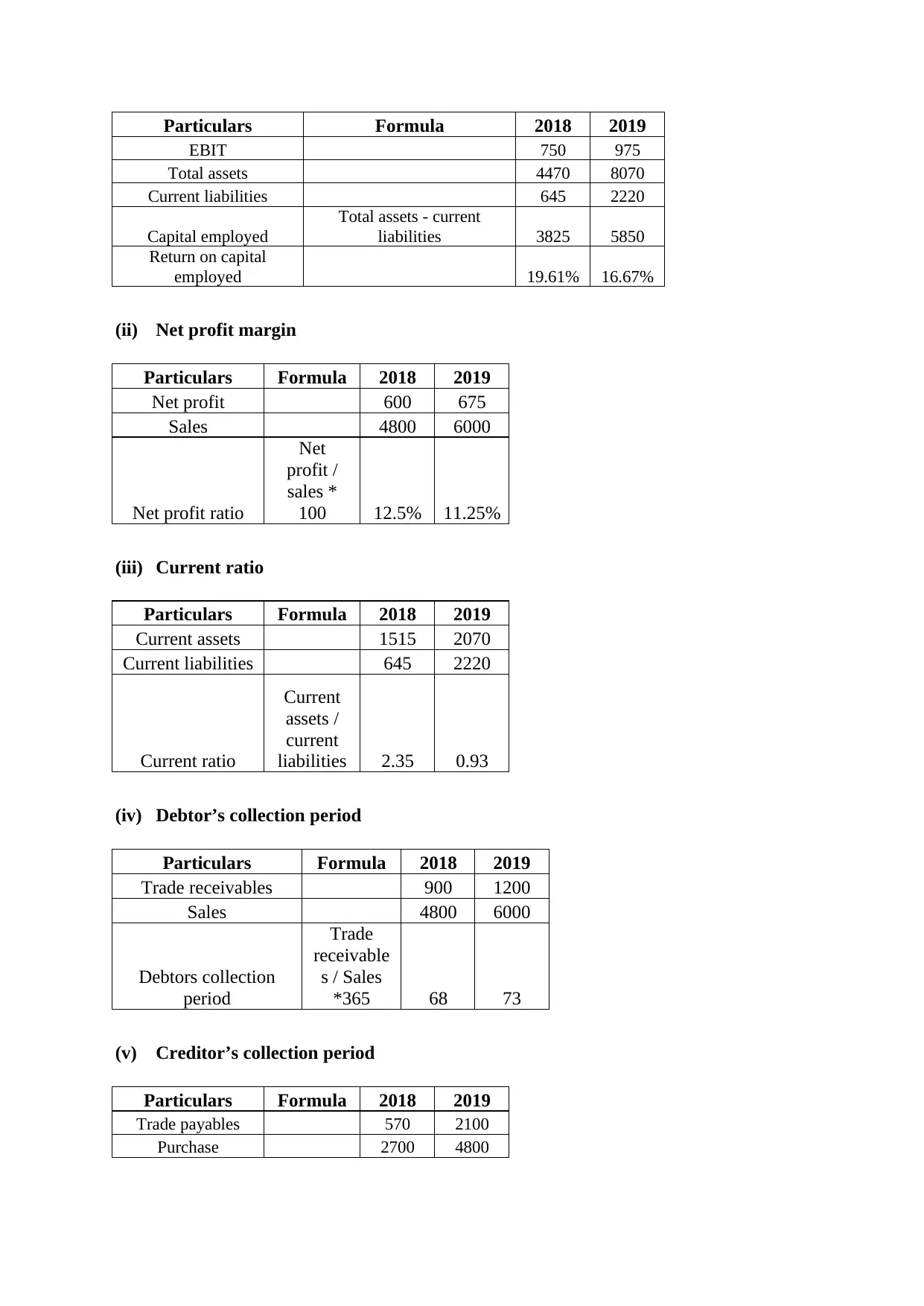
Particulars Formula 2018 2019
EBIT 750 975
Total assets 4470 8070
Current liabilities 645 2220
Capital employed
Total assets - current
liabilities 3825 5850
Return on capital
employed 19.61% 16.67%
(ii) Net profit margin
Particulars Formula 2018 2019
Net profit 600 675
Sales 4800 6000
Net profit ratio
Net
profit /
sales *
100 12.5% 11.25%
(iii) Current ratio
Particulars Formula 2018 2019
Current assets 1515 2070
Current liabilities 645 2220
Current ratio
Current
assets /
current
liabilities 2.35 0.93
(iv) Debtor’s collection period
Particulars Formula 2018 2019
Trade receivables 900 1200
Sales 4800 6000
Debtors collection
period
Trade
receivable
s / Sales
*365 68 73
(v) Creditor’s collection period
Particulars Formula 2018 2019
Trade payables 570 2100
Purchase 2700 4800
EBIT 750 975
Total assets 4470 8070
Current liabilities 645 2220
Capital employed
Total assets - current
liabilities 3825 5850
Return on capital
employed 19.61% 16.67%
(ii) Net profit margin
Particulars Formula 2018 2019
Net profit 600 675
Sales 4800 6000
Net profit ratio
Net
profit /
sales *
100 12.5% 11.25%
(iii) Current ratio
Particulars Formula 2018 2019
Current assets 1515 2070
Current liabilities 645 2220
Current ratio
Current
assets /
current
liabilities 2.35 0.93
(iv) Debtor’s collection period
Particulars Formula 2018 2019
Trade receivables 900 1200
Sales 4800 6000
Debtors collection
period
Trade
receivable
s / Sales
*365 68 73
(v) Creditor’s collection period
Particulars Formula 2018 2019
Trade payables 570 2100
Purchase 2700 4800
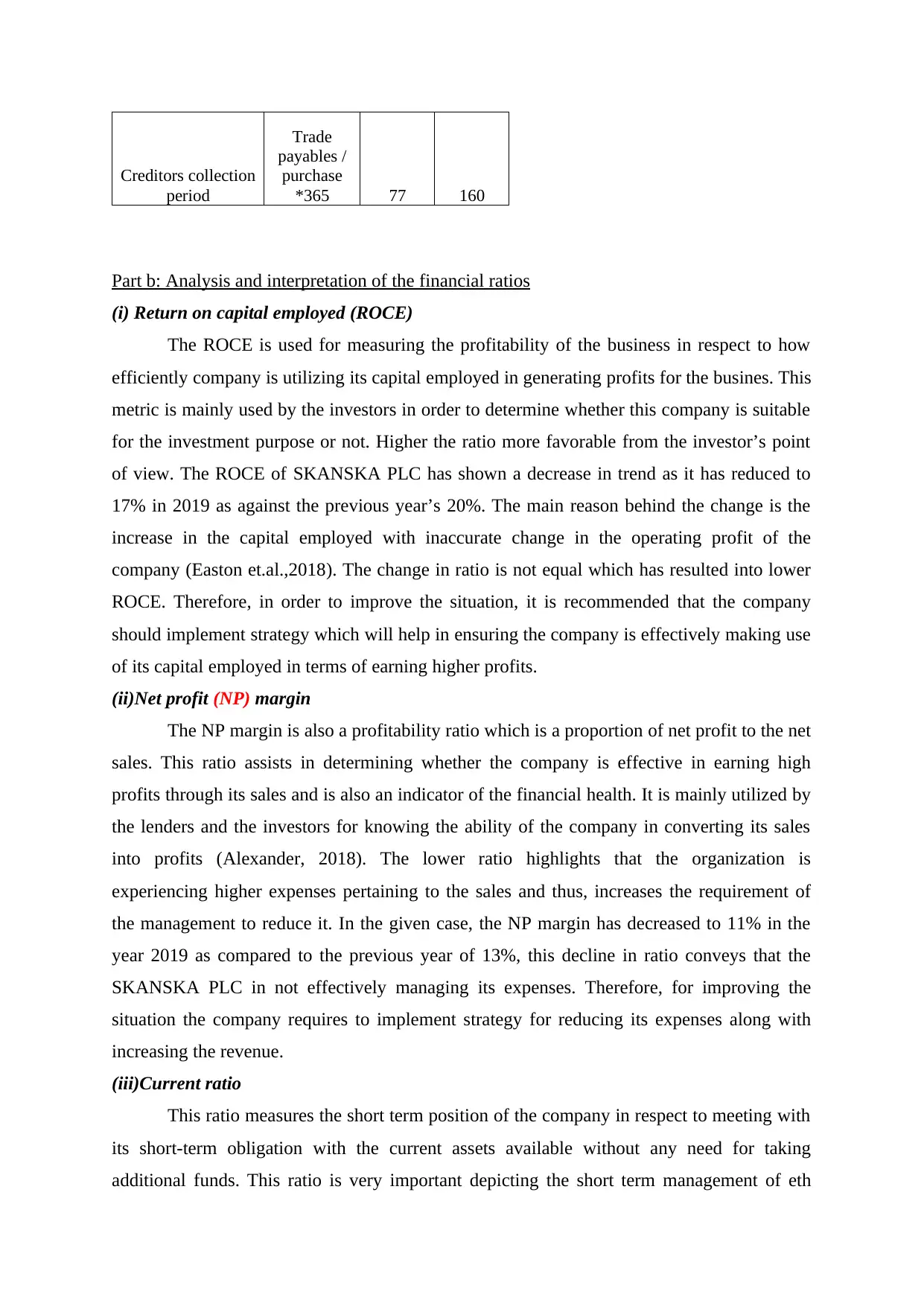
Creditors collection
period
Trade
payables /
purchase
*365 77 160
Part b: Analysis and interpretation of the financial ratios
(i) Return on capital employed (ROCE)
The ROCE is used for measuring the profitability of the business in respect to how
efficiently company is utilizing its capital employed in generating profits for the busines. This
metric is mainly used by the investors in order to determine whether this company is suitable
for the investment purpose or not. Higher the ratio more favorable from the investor’s point
of view. The ROCE of SKANSKA PLC has shown a decrease in trend as it has reduced to
17% in 2019 as against the previous year’s 20%. The main reason behind the change is the
increase in the capital employed with inaccurate change in the operating profit of the
company (Easton et.al.,2018). The change in ratio is not equal which has resulted into lower
ROCE. Therefore, in order to improve the situation, it is recommended that the company
should implement strategy which will help in ensuring the company is effectively making use
of its capital employed in terms of earning higher profits.
(ii)Net profit (NP) margin
The NP margin is also a profitability ratio which is a proportion of net profit to the net
sales. This ratio assists in determining whether the company is effective in earning high
profits through its sales and is also an indicator of the financial health. It is mainly utilized by
the lenders and the investors for knowing the ability of the company in converting its sales
into profits (Alexander, 2018). The lower ratio highlights that the organization is
experiencing higher expenses pertaining to the sales and thus, increases the requirement of
the management to reduce it. In the given case, the NP margin has decreased to 11% in the
year 2019 as compared to the previous year of 13%, this decline in ratio conveys that the
SKANSKA PLC in not effectively managing its expenses. Therefore, for improving the
situation the company requires to implement strategy for reducing its expenses along with
increasing the revenue.
(iii)Current ratio
This ratio measures the short term position of the company in respect to meeting with
its short-term obligation with the current assets available without any need for taking
additional funds. This ratio is very important depicting the short term management of eth
period
Trade
payables /
purchase
*365 77 160
Part b: Analysis and interpretation of the financial ratios
(i) Return on capital employed (ROCE)
The ROCE is used for measuring the profitability of the business in respect to how
efficiently company is utilizing its capital employed in generating profits for the busines. This
metric is mainly used by the investors in order to determine whether this company is suitable
for the investment purpose or not. Higher the ratio more favorable from the investor’s point
of view. The ROCE of SKANSKA PLC has shown a decrease in trend as it has reduced to
17% in 2019 as against the previous year’s 20%. The main reason behind the change is the
increase in the capital employed with inaccurate change in the operating profit of the
company (Easton et.al.,2018). The change in ratio is not equal which has resulted into lower
ROCE. Therefore, in order to improve the situation, it is recommended that the company
should implement strategy which will help in ensuring the company is effectively making use
of its capital employed in terms of earning higher profits.
(ii)Net profit (NP) margin
The NP margin is also a profitability ratio which is a proportion of net profit to the net
sales. This ratio assists in determining whether the company is effective in earning high
profits through its sales and is also an indicator of the financial health. It is mainly utilized by
the lenders and the investors for knowing the ability of the company in converting its sales
into profits (Alexander, 2018). The lower ratio highlights that the organization is
experiencing higher expenses pertaining to the sales and thus, increases the requirement of
the management to reduce it. In the given case, the NP margin has decreased to 11% in the
year 2019 as compared to the previous year of 13%, this decline in ratio conveys that the
SKANSKA PLC in not effectively managing its expenses. Therefore, for improving the
situation the company requires to implement strategy for reducing its expenses along with
increasing the revenue.
(iii)Current ratio
This ratio measures the short term position of the company in respect to meeting with
its short-term obligation with the current assets available without any need for taking
additional funds. This ratio is very important depicting the short term management of eth
⊘ This is a preview!⊘
Do you want full access?
Subscribe today to unlock all pages.

Trusted by 1+ million students worldwide
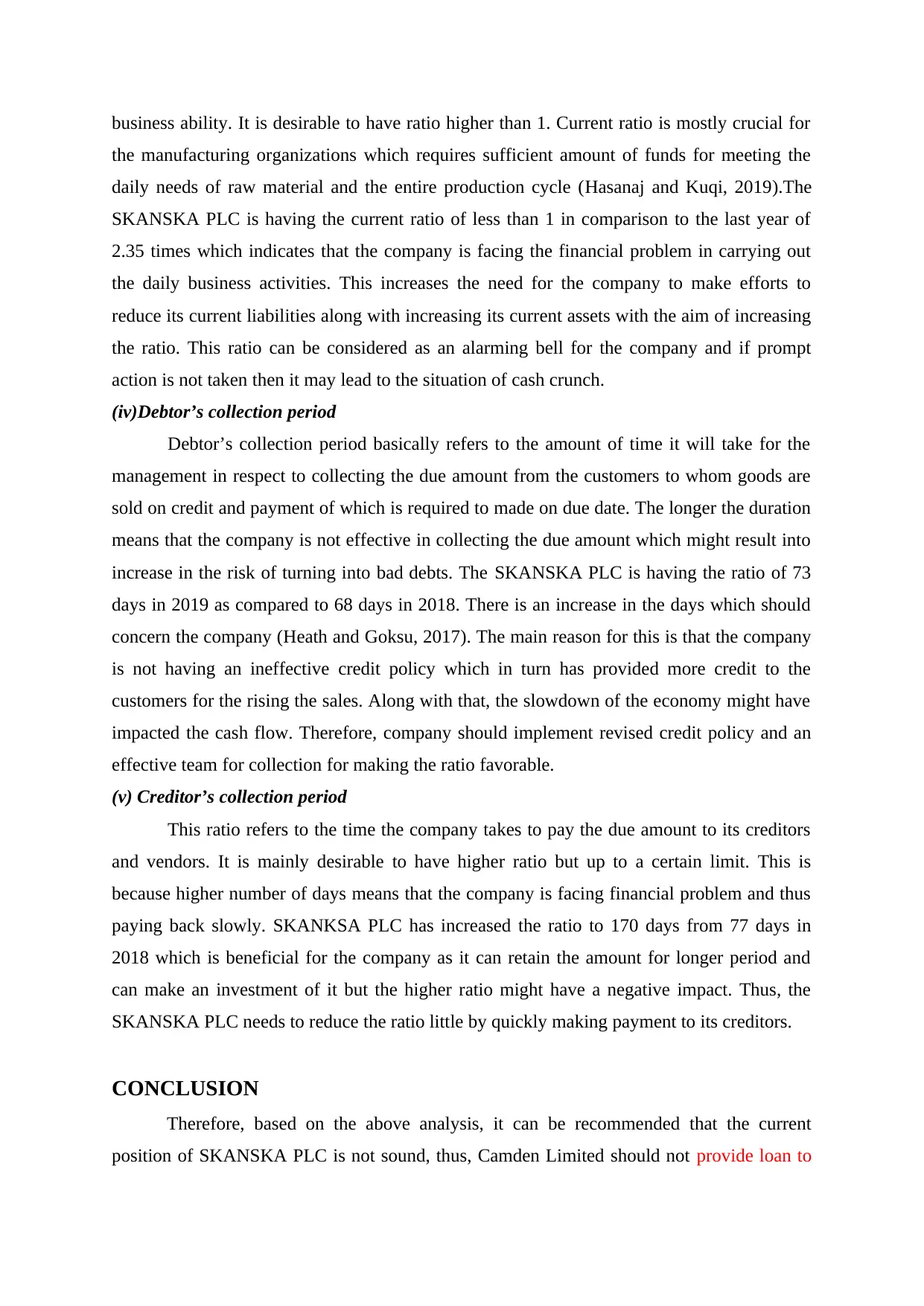
business ability. It is desirable to have ratio higher than 1. Current ratio is mostly crucial for
the manufacturing organizations which requires sufficient amount of funds for meeting the
daily needs of raw material and the entire production cycle (Hasanaj and Kuqi, 2019).The
SKANSKA PLC is having the current ratio of less than 1 in comparison to the last year of
2.35 times which indicates that the company is facing the financial problem in carrying out
the daily business activities. This increases the need for the company to make efforts to
reduce its current liabilities along with increasing its current assets with the aim of increasing
the ratio. This ratio can be considered as an alarming bell for the company and if prompt
action is not taken then it may lead to the situation of cash crunch.
(iv)Debtor’s collection period
Debtor’s collection period basically refers to the amount of time it will take for the
management in respect to collecting the due amount from the customers to whom goods are
sold on credit and payment of which is required to made on due date. The longer the duration
means that the company is not effective in collecting the due amount which might result into
increase in the risk of turning into bad debts. The SKANSKA PLC is having the ratio of 73
days in 2019 as compared to 68 days in 2018. There is an increase in the days which should
concern the company (Heath and Goksu, 2017). The main reason for this is that the company
is not having an ineffective credit policy which in turn has provided more credit to the
customers for the rising the sales. Along with that, the slowdown of the economy might have
impacted the cash flow. Therefore, company should implement revised credit policy and an
effective team for collection for making the ratio favorable.
(v) Creditor’s collection period
This ratio refers to the time the company takes to pay the due amount to its creditors
and vendors. It is mainly desirable to have higher ratio but up to a certain limit. This is
because higher number of days means that the company is facing financial problem and thus
paying back slowly. SKANKSA PLC has increased the ratio to 170 days from 77 days in
2018 which is beneficial for the company as it can retain the amount for longer period and
can make an investment of it but the higher ratio might have a negative impact. Thus, the
SKANSKA PLC needs to reduce the ratio little by quickly making payment to its creditors.
CONCLUSION
Therefore, based on the above analysis, it can be recommended that the current
position of SKANSKA PLC is not sound, thus, Camden Limited should not provide loan to
the manufacturing organizations which requires sufficient amount of funds for meeting the
daily needs of raw material and the entire production cycle (Hasanaj and Kuqi, 2019).The
SKANSKA PLC is having the current ratio of less than 1 in comparison to the last year of
2.35 times which indicates that the company is facing the financial problem in carrying out
the daily business activities. This increases the need for the company to make efforts to
reduce its current liabilities along with increasing its current assets with the aim of increasing
the ratio. This ratio can be considered as an alarming bell for the company and if prompt
action is not taken then it may lead to the situation of cash crunch.
(iv)Debtor’s collection period
Debtor’s collection period basically refers to the amount of time it will take for the
management in respect to collecting the due amount from the customers to whom goods are
sold on credit and payment of which is required to made on due date. The longer the duration
means that the company is not effective in collecting the due amount which might result into
increase in the risk of turning into bad debts. The SKANSKA PLC is having the ratio of 73
days in 2019 as compared to 68 days in 2018. There is an increase in the days which should
concern the company (Heath and Goksu, 2017). The main reason for this is that the company
is not having an ineffective credit policy which in turn has provided more credit to the
customers for the rising the sales. Along with that, the slowdown of the economy might have
impacted the cash flow. Therefore, company should implement revised credit policy and an
effective team for collection for making the ratio favorable.
(v) Creditor’s collection period
This ratio refers to the time the company takes to pay the due amount to its creditors
and vendors. It is mainly desirable to have higher ratio but up to a certain limit. This is
because higher number of days means that the company is facing financial problem and thus
paying back slowly. SKANKSA PLC has increased the ratio to 170 days from 77 days in
2018 which is beneficial for the company as it can retain the amount for longer period and
can make an investment of it but the higher ratio might have a negative impact. Thus, the
SKANSKA PLC needs to reduce the ratio little by quickly making payment to its creditors.
CONCLUSION
Therefore, based on the above analysis, it can be recommended that the current
position of SKANSKA PLC is not sound, thus, Camden Limited should not provide loan to
Paraphrase This Document
Need a fresh take? Get an instant paraphrase of this document with our AI Paraphraser

it, by looking at the ROCE, current ratio and debtor’s collection period which are very poor,
thus, making it riskier for Camden Limited. This is because of the reason that the company is
struggling in terms of liquidity and profitability and for improving the circumstances requires
implementing remedial actions on a prompt basis.
thus, making it riskier for Camden Limited. This is because of the reason that the company is
struggling in terms of liquidity and profitability and for improving the circumstances requires
implementing remedial actions on a prompt basis.
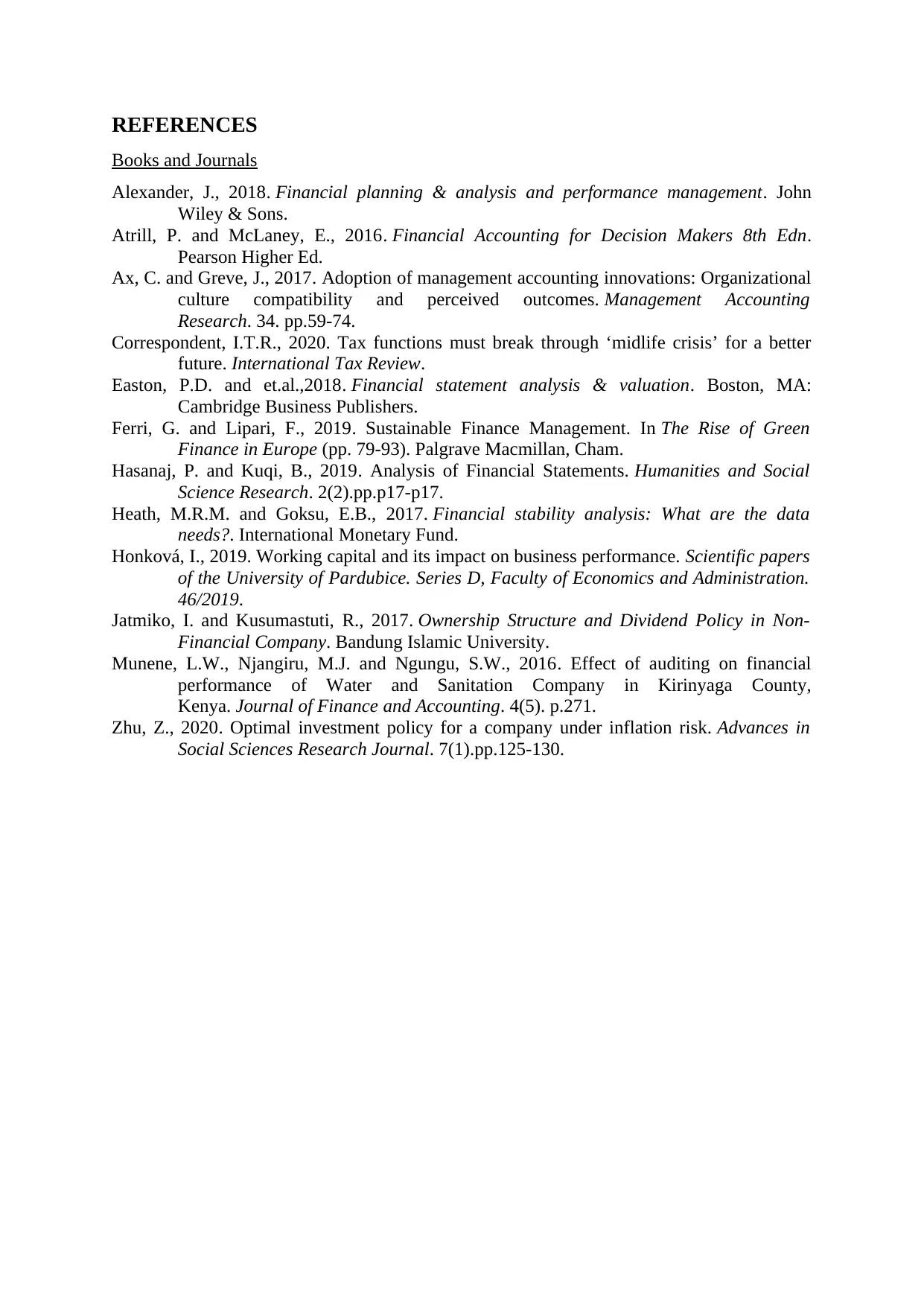
REFERENCES
Books and Journals
Alexander, J., 2018. Financial planning & analysis and performance management. John
Wiley & Sons.
Atrill, P. and McLaney, E., 2016. Financial Accounting for Decision Makers 8th Edn.
Pearson Higher Ed.
Ax, C. and Greve, J., 2017. Adoption of management accounting innovations: Organizational
culture compatibility and perceived outcomes. Management Accounting
Research. 34. pp.59-74.
Correspondent, I.T.R., 2020. Tax functions must break through ‘midlife crisis’ for a better
future. International Tax Review.
Easton, P.D. and et.al.,2018. Financial statement analysis & valuation. Boston, MA:
Cambridge Business Publishers.
Ferri, G. and Lipari, F., 2019. Sustainable Finance Management. In The Rise of Green
Finance in Europe (pp. 79-93). Palgrave Macmillan, Cham.
Hasanaj, P. and Kuqi, B., 2019. Analysis of Financial Statements. Humanities and Social
Science Research. 2(2).pp.p17-p17.
Heath, M.R.M. and Goksu, E.B., 2017. Financial stability analysis: What are the data
needs?. International Monetary Fund.
Honková, I., 2019. Working capital and its impact on business performance. Scientific papers
of the University of Pardubice. Series D, Faculty of Economics and Administration.
46/2019.
Jatmiko, I. and Kusumastuti, R., 2017. Ownership Structure and Dividend Policy in Non-
Financial Company. Bandung Islamic University.
Munene, L.W., Njangiru, M.J. and Ngungu, S.W., 2016. Effect of auditing on financial
performance of Water and Sanitation Company in Kirinyaga County,
Kenya. Journal of Finance and Accounting. 4(5). p.271.
Zhu, Z., 2020. Optimal investment policy for a company under inflation risk. Advances in
Social Sciences Research Journal. 7(1).pp.125-130.
Books and Journals
Alexander, J., 2018. Financial planning & analysis and performance management. John
Wiley & Sons.
Atrill, P. and McLaney, E., 2016. Financial Accounting for Decision Makers 8th Edn.
Pearson Higher Ed.
Ax, C. and Greve, J., 2017. Adoption of management accounting innovations: Organizational
culture compatibility and perceived outcomes. Management Accounting
Research. 34. pp.59-74.
Correspondent, I.T.R., 2020. Tax functions must break through ‘midlife crisis’ for a better
future. International Tax Review.
Easton, P.D. and et.al.,2018. Financial statement analysis & valuation. Boston, MA:
Cambridge Business Publishers.
Ferri, G. and Lipari, F., 2019. Sustainable Finance Management. In The Rise of Green
Finance in Europe (pp. 79-93). Palgrave Macmillan, Cham.
Hasanaj, P. and Kuqi, B., 2019. Analysis of Financial Statements. Humanities and Social
Science Research. 2(2).pp.p17-p17.
Heath, M.R.M. and Goksu, E.B., 2017. Financial stability analysis: What are the data
needs?. International Monetary Fund.
Honková, I., 2019. Working capital and its impact on business performance. Scientific papers
of the University of Pardubice. Series D, Faculty of Economics and Administration.
46/2019.
Jatmiko, I. and Kusumastuti, R., 2017. Ownership Structure and Dividend Policy in Non-
Financial Company. Bandung Islamic University.
Munene, L.W., Njangiru, M.J. and Ngungu, S.W., 2016. Effect of auditing on financial
performance of Water and Sanitation Company in Kirinyaga County,
Kenya. Journal of Finance and Accounting. 4(5). p.271.
Zhu, Z., 2020. Optimal investment policy for a company under inflation risk. Advances in
Social Sciences Research Journal. 7(1).pp.125-130.
⊘ This is a preview!⊘
Do you want full access?
Subscribe today to unlock all pages.

Trusted by 1+ million students worldwide
1 out of 12
Related Documents
Your All-in-One AI-Powered Toolkit for Academic Success.
+13062052269
info@desklib.com
Available 24*7 on WhatsApp / Email
![[object Object]](/_next/static/media/star-bottom.7253800d.svg)
Unlock your academic potential
Copyright © 2020–2025 A2Z Services. All Rights Reserved. Developed and managed by ZUCOL.




